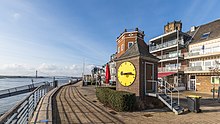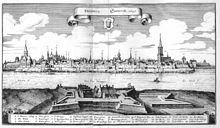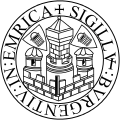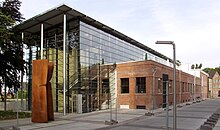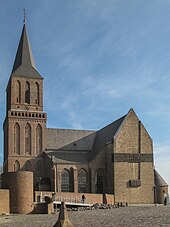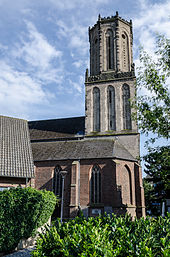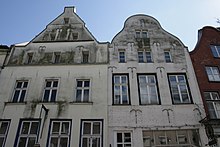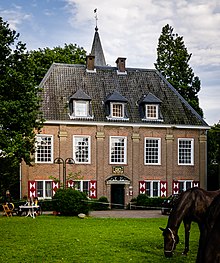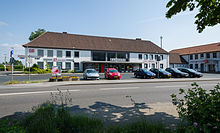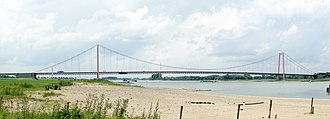Emmerich on the Rhine
| coat of arms | Germany map | |
|---|---|---|

|
Coordinates: 51 ° 50 ′ N , 6 ° 15 ′ E |
|
| Basic data | ||
| State : | North Rhine-Westphalia | |
| Administrative region : | Dusseldorf | |
| Circle : | Kleve | |
| Height : | 17 m above sea level NHN | |
| Area : | 80.4 km 2 | |
| Residents: | 30,961 (Dec. 31, 2019) | |
| Population density : | 385 inhabitants per km 2 | |
| Postal code : | 46446 | |
| Primaries : | 02822, 02828 | |
| License plate : | KLE, GEL | |
| Community key : | 05 1 54 008 | |
| LOCODE : | DE EMM | |
| City structure: | 10 districts | |
City administration address : |
Geistmarkt 1 46446 Emmerich am Rhein |
|
| Website : | ||
| Mayor : | Peter Hinze ( SPD ) | |
| Location of the city of Emmerich on the Rhine in the Kleve district | ||
Emmerich am Rhein is a Hanseatic city on the lower right of the Lower Rhine in the northwest of the state of North Rhine-Westphalia . As a middle district town it belongs to the district of Kleve in the administrative district of Düsseldorf . Emmerich is a member of the Euregio Rhine-Waal and the Rhenish Hanseatic League .
geography
Geographical location
Emmerich geographically belongs to the Lower Rhine valley , part of the Lower Rhine lowlands . The city center is at a height of 17 meters above sea level . The lowest point of the urban area is in the foreland of the Rhine at 13 meters. The Eltenberg with an altitude of up to 82 meters is assigned to the natural spatial main unit of the Elten Heights .
Expansion of the urban area
The Emmerich urban area is bounded in the south by the Rhine (Rhine center), in the west and north by the state border with the Netherlands. In the east it borders on the Rees city area.
The total area of the urban area is 8040 hectares .
A division of the cadastral area in the official statistics according to the actual type of use results in 61.3% agricultural use, 8.1% forest area, 7.2% water area, 1.9% recreation and cemetery area, 13.8% buildings -, open and operating area, 7.4% traffic area and 0.4% other areas (as of December 31, 2015).
A slightly different picture of land use emerges when analyzing satellite images. Of the total area of the urban area, 43.16% are used as meadow and pasture and 27.81% as arable land. 14.17% are sealed (4.28% low degree of sealing (<40%), 7.27% medium degree of sealing (40–80%), 2.62% high degree of sealing (> 80%)). Forest consists of 10.42% of the area (coniferous forest 1.38%, mixed forest 2.93%, deciduous forest 6.11%). 4.2% are water surfaces, 0.24% are gravel pits / mining areas or construction sites.
City structure
Spatially, the urban area is divided into the following ten districts (population figures as of January 1, 2017, source: KRZN)
- three districts in a historical area (19,387 inhabitants):
- seven districts from formerly independent communities :
The difference between the number of inhabitants and the above-mentioned total number of inhabitants is based on the different counting method between LDS and KRZN .
Neighboring communities
The city of Emmerich am Rhein borders in the north on the municipalities of Montferland and Oude IJsselstreek (both in the province of Gelderland ( NL )), in the east on the city of Rees , in the south in the middle of the Rhine on the cities of Kleve and Kalkar and in the north-west on the municipality Zevenaar (in the province of Gelderland (NL)).
| Zevenaar (NL) | Montferland (NL) | Oude IJsselstreek (NL) |

|
Rees | |
| Kleve | Kalkar |
history
middle Ages
Around 700 Willibrord founded the Emmerich mission station in the diocese of Utrecht and consecrated the first St. Martin's Church . Some early medieval graves were discovered a little east of today's city center in 1963, which were quite richly furnished for their time (early 8th century). A Latin school was established at the Martinistift , one of the first schools in Germany today. The first written mention under the name Villa Embrici comes from the year 828. After the Norman storm in the 9th century, the provost of the collegiate monastery ruled the place. In 1040 the collegiate church of St. Martini was built.
On May 31, 1233, Count Otto von Zutphen and Geldern raised Emmerich to the status of town with the authorization of the Roman Emperor Friedrich II and the German King Heinrich (VII) (father and son). The constitution and privileges corresponded to those of the city of Zütphen . In 1355 Emmerich was pledged to Count Johann von Kleve and remained with the county or the Duchy of Kleve . Between 1307 and 1570 Emmerich was closely connected to the Hanseatic League . Trade and handicrafts flourished. In addition to the brewery , it was primarily the wool weaving mill , whose guild in the city reached back to 1299, established the prosperity. Emmerich has been surrounded by walls and secured with gates since the 14th century. The Aldegundis Church dates from the 15th century.
Modern times
Emmerich, which flourished up to the 16th century, was called Embrica decora (= magnificent Emmerich) because of its secular and ecclesiastical buildings . In 1567 the Hanseatic Day took place in the Emmerich Kreuzherrenkloster . The Christoffeltor on the banks of the Rhine, which was blown up during the Second World War, was known for its larger than life, oak figure of Christophorus in the niche above the portal facing the field. The sculpture from the beginning of the 16th century, attributed to the master Dries Holthuys , has been in the Rheinmuseum in Emmerich since 1964. A cast of this Christophorus figure stands today on a stele at the Christoffeltor.
The Cologne canon and Emmerich provost of the collegiate monastery of St. Martin, Count Moritz von Spiegelberg (1406 / 07–1483), reformed the Latin school into a school of scholars : teachers such as Alexander Hegius (1439–1498), Peter Homphaeus (1480–1556), Matthias Bredenbach (1499–1559) and Heinrich Uranius (1492–1572) taught there. Schoolchildren came from far away; under Rector Bredenbach, 2000 boys are said to have attended grammar school. After a sharp decline, the Jesuits from Cologne took over the lessons in 1592 , which they gave again to up to 500 students after the regional withdrawal of both warring parties in the Dutch-Spanish war after 1600. The training was attractive to Catholic Dutch people. In 1614 the anti-Catholic Dutch under Moritz von Oranien reoccupied the city from Schenkenschanz in union with Brandenburg , to which the Duchy of Cleves had fallen. In 1609 a new school building was built on Wollenweberstrasse. The old building (since 1505) on the Geistmarkt, an elongated, three-story brick building with a roof turret, which was located between the town hall and the Evangelical Church, served as a French Reformed church from 1673 to 1715 . The grammar school in Kleve accepted Protestant Reformed students. There was also a small but respected Jewish community, known as the Gomperz family . The Jesuit grammar school was closed in 1788 due to the ban on religious orders , after which the Lords of the Cross took over teaching. With Napoleon I's ban, classes temporarily ended in 1811.
In the Thirty Years War , Emmerich suffered even less because of the Dutch occupation. The decline of Emmerich began in 1672 with the occupation of the city by French troops under King Louis XIV. War devastation, floods and epidemics left the city impoverished. The tribulations related to the War of the Spanish Succession , the Seven Years' War , the military consequences of the French Revolution and the Napoleonic subjugation followed.
It was not until 1815 that Emmerich returned to the Kingdom of Prussia and was economically strengthened by navigation on the Rhine and industrialization. In May 1832 the king had a new humanistic grammar school opened. On August 24, 1857, the city was awarded the Rhenish City Code .
On October 20, 1856, the Dutch route of the Cologne-Mindener Railway was opened, which was originally not supposed to go via Emmerich, but the city of Emmerich had raised an objection. In 1865 a railway ferry across the Rhine was put into operation. The Spyck-Welle trajectory was operated until 1912.
Telephone traffic was established in 1890.
20./21. century
In July 1901 Emmerich had over 10,000 inhabitants for the first time . In 1905 the city generated electric power station the first electricity for the city .
During the First World War , Emmerich was a garrison town . Post and rail traffic was restricted, the border controls previously carried out in Emmerich were relocated to Elten. Emmerich was the start and end of the Prussian trains. During the First World War , Emmerich was the largest postal surveillance office in the empire . On November 20, 1918, a workers 'and soldiers' council was founded in Emmerich . Belgian troops occupied Emmerich on December 17th and left the city in 1921 . During the war against the Ruhr on February 13, 1923, the city was again occupied.
Between November 6, 1914 and February 24, 1945 trams operated by the Wesel – Rees – Emmerich small railway and between June 4, 1903 and September 18, 1944, the Dutch small railway tram Zutphen – Emmerich operated .
During the Second World War , Emmerich was 91% destroyed by an air raid by the British Royal Air Force on October 7, 1944 .
In 1949 Elten was annexed to the Netherlands as part of the Dutch annexation plans after the Second World War . The reintegration to the Federal Republic of Germany was decided by a contract dated April 8, 1960 and carried out on August 1, 1963.
On 7 October 1960, the wrecked ship Tina Scarlett at a disaster of inland navigation with two dead and 22 partly serious injuries on the Rhine at Emmerich. Ten ships burned, the Rhine was on fire at 300 meters.
The federal motorway 3 was released in 1962 on the section from customs crossing point Elten to junction Emmerich. On April 27, 1965, the last section of the Holland line between Emmerich and Hamminkeln was opened. On June 18, 1965, the topping-out ceremony took place at the newly built Emmerich bridge after three years of construction; it was opened on September 3, 1965.
In 1966 the Dutch route was electrified.
From 1969 to 2008 Emmerich was again a garrison town . In-built in the 1960s, Moritz von Nassau - barracks were initially the heavy engineer battalion 716, later the heavy engineer battalion 800, then the engineer battalion 140 , the pioneering training center 800 and the semi-active engineer battalion 810 and other smaller departments with a total of about 900 soldiers stationed. The Emmerich site was closed on June 30, 2008.
Since December 1, 2001 the city has been called Emmerich am Rhein .
Incorporations
In 1903 the places Leegmeer and were Speelberg in the city Emmerich incorporated .
On July 1, 1969, in the course of the first municipal reorganization program based on the law on the reorganization of municipalities in the Rees district, the previously independent municipalities of Borghees , Hüthum and Klein-Netterden of the former Office of Elten and the municipalities of Dornick , Praest and Vrasselt of the former Office Vrasselt merged with the city of Emmerich.
On January 1, 1975, the municipality of Elten was incorporated into the city of Emmerich on the basis of the Lower Rhine Act in the course of the second reorganization program.
At the same time, the old Rees district was dissolved and the former northern district area was merged with the former Geldern district and parts of the Moers district to form the new Lower Rhine greater Kleve district. Since then, Emmerich has been a municipality in the Kleve district.
Population development
| year | Residents |
|---|---|
| 1532 | 3,250 |
| 1816 | 4,442 |
| 1858 | 7,397 |
| 1871 | 7,809 |
| 1880 | 8,900 |
| 1885 | 9,759 |
| 1890 | 9,622 |
| 1895 | 9,946 |
| 1900 | 10,526 |
| 1910 | 13,418 |
| 1925 | 13,647 |
| year | Residents |
|---|---|
| 1933 | 14,545 |
| 1939 | 16,381 |
| 1945 | 441 |
| 1946 | 7,022 |
| 1950 | 9,074 |
| 1961 | 16,822 |
| 1968 | 18,356 |
| 1970 | 24,122 |
| 1974 | 24,860 |
| 1987 | 27,924 |
| 2011 | 29,918 |
Annual population figures have been available since 1975:

Religions
The majority of the people from Emmerich are Roman Catholic (61.7%), a smaller part Protestant (16.6%). 21.7% of the people from Emmerich belong to another religion or no religion or did not provide any information on religious affiliation. In addition to the above-mentioned communities there is an Eritrean Orthodox community, a Sunni mosque community , a Yezidi community, an Alevi community, a new apostolic and apostolic church. (Figures: 2011 census)
Christianity
- In Emmerich there is a Roman Catholic pastoral care unit with two parishes as well as another parish.
- The pastoral care unit St. Christophorus and St. John the Baptist spatially covers the districts of Altstadt, Leegmeer, Speelberg, Vrasselt, Praest and Dornick. On November 28, 2004 the four Catholic parishes of St. Martini, St. Aldegundis, Heilig-Geist and Liebfrauen were merged to form the new parish of St. Christophorus.
- The parish of St. John the Baptist includes the eponymous church in Dornick, St. Antonius in Vrasselt, and St. John the Baptist in Praest.
- The parish of St. Vitus consists of the merged parishes of St. Georg in Hüthum, St. Martinus in Elten and St. Vitus in Hochelten.
- The Catholic parishes of Emmerich belong to the Emmerich dean's office in the Kleve district dean's office in the Münster diocese .
- The Polish Catholic community is formally part of the parish of St. Christophorus, but in practice has little contact with German-speaking community life. A Polish pastor holds a Sunday mass in the Aldegundis Church for the largest group of immigrants in Emmerich.
- The Protestant parish of Emmerich can trace its origins back to the year 1574, when a reformed congregation was founded with the participation of descendants of refugee Waldensians and Dutch immigrants . Approx. In 1609 a Mennonite congregation was formed. A street in the city center is reminiscent of them. A Lutheran congregation had existed since 1626 at the latest. In 1686 Huguenot refugees from France founded a French Reformed congregation. In 1817 - decreed by the King of Prussia - the Reformed and Lutheran congregations were united. The community belongs to the parish of Wesel of the Evangelical Church in the Rhineland .
- The New Apostolic congregation Emmerich was founded in 1925 and has around 100 members. It has had its own church building since 1930. It belongs to the Dinslaken district.
- The apostolic congregation in Emmerich was founded in 1955 as a split from the New Apostolic congregation. In 1965 a separate church building was built. The community has about 50 members and belongs to the northern region.
- The Eritrean Orthodox community has members from the entire Kleve district as well as from Bocholt and Wesel. She uses the crypt of the Martinikirche for her Sunday services.
Judaism
A Jewish community had existed in Emmerich since the first third of the 17th century, which had belonged to the Rees synagogue district as a branch since 1854, before an independent synagogue community was formed around 1900. In 1932 Elten was affiliated. The size of the congregation was 87 people in 1816, 151 in 1885 and in 1932 about 90–95 members. In June 1933, 86 Jews lived in what was then the Emmerich city area. Many of them were deported and murdered in the Holocaust . This is reminiscent of 99 stumbling blocks in the city area, which were laid in 2011–2012 by Gunter Demnig with the help of Emmerich students.
A prayer room was occupied at the beginning of the 17th century, around 1674 a residential building was converted into a synagogue, which was renovated in 1811/12 and repaired again in 1926/27. The synagogue was sold in August 1938 and was not damaged during the November pogroms. In 1944 it was destroyed by bombs. The ruin was demolished around 1955. There is a memorial plaque at the former location in today's Willibrordstrasse.
Today Emmerich belongs to the area of the Jewish community Duisburg-Mülheim / Ruhr-Oberhausen . The closest synagogues are in Duisburg and Oberhausen.
Islam
- The Turkish-Islamic Cultural Association , which runs the Sunni "Great Mosque " (Turkish: Ulu Camii ), has around 70 members . The association belongs to the umbrella organization Turkish-Islamic Union of the Institute for Religion (DITIB).
- About 50 families belong to the Alevi community. The community operates a meeting house in Emmerich, the Alevi Cultural Center .
Yezidism
Kurdish migrant workers and refugees founded the Yezidi cultural community in the district of Kleve and the surrounding area in 1993, based in Emmerich. The community center has also been located here since 2003. The association belongs to the Federation of Yezidi Kurds . Already in 1990 a Yazidi burial ground was laid out in the Emmerich municipal cemetery.
politics
City council
In addition to the nationally represented parties, two local electoral associations are active in Emmerich's municipal politics: The Emmerich Citizens' Community (BGE) and the Association of Social Democrats (BSD).
Since the last local election on May 25, 2014, the CDU (38.9%, 13 seats), SPD (29.0%, 10 seats), BGE (18.8%, 6 seats), Greens (6.1 %, 2 seats), FDP (3.5%, 1 seat), BSD (2.1%, 1 seat) and Leftists (1.7%, 1 seat). The turnout was 42.8%. The council members of the FDP, BSD and Left have come together to form the "Embrica" faction.
At the beginning of 2017, two council members left the BGE and founded the UWE (Independent Voters Emmerich) parliamentary group. After the unexpected death of a council member and the accession of a previously non-attached mandate holder, the UWE parliamentary group will continue to exist in a changed composition from 04/2017.
The next local election will take place on September 13, 2020.
mayor
Mayor of the city of Emmerich am Rhein has been Peter Hinze (SPD) since 2015.
In the mayoral election on September 13, 2015, no candidate achieved an absolute majority, so that the mayor had to be determined in a runoff between the two candidates with the most votes. Of the valid votes cast, Peter Hinze (SPD) received 37.6%, Johannes Diks (CDU) 32.2%, Joachim Sigmund (BGE) 27.1% and David Krüger (BSD.NRW) 3.2% %. The turnout was 42.4%.
The runoff election between the candidates Hinze and Diks took place on September 27, 2015. With a turnout of 41.5%, Hinze was elected with 67.2%.
The next mayoral election will take place on September 13, 2020.
Coat of arms and seal
“The city has a talking coat of arms that has appeared on city seals from the 14th century since the Middle Ages. In 1233, Emmerich was given city rights by Count Otto von Geldern .
In Emmerich the coat of arms and seal are next to each other.
The coat of arms is a white pail standing in a red coat of arms . The image of the city seal : three round fortress towers rise behind a crenellated city wall. The wider central tower is designed as a crenellated round tower up to half its height, but then merges into a slimmer square tower in the upper part, which ends with a parapet protruding on all sides and a folded hood. The lower side towers also have folding roofs. Above them, on both sides of the central tower, there are two inclined coats of arms, each showing a bucket. Inscription Sigillum Burgentium in Embrica. "
The inscription means seal of the citizens in Emmerich . A coat of arms is not proven. It is rare for a city's coat of arms and seals to be different. The origin of the bucket on the coat of arms could not be clarified even by an expert opinion (1910). The question of whether it is a talking coat of arms is also controversial.
Flag and banner
The city's flag (as a banner) is divided lengthways into the colors red (left) and white (right). In a hoisted flag, the top part of the flag is red and the bottom part is white. In the middle is the coat of arms in red with the standing, hanging white bucket.
Town twinning
Emmerich maintains city partnerships with the following cities :
-
 King's Lynn ( UK , since 1978)
King's Lynn ( UK , since 1978) -
 Šilutė ( Lithuania , since 1990)
Šilutė ( Lithuania , since 1990) -
 Kirkland (Washington) ( United States , since 1995)
Kirkland (Washington) ( United States , since 1995)
Culture and sights
Museums
- Rhine Museum
- In the Rhine Museum over 150 model ships , a radar system , fish preparations, maps of the Rhine, a historical figure of Christophorus and a city history collection are shown. You can also see a one-man submarine , type BIBER from World War II, and exhibitions on navigation on the Rhine, the history of the city and fishing.
- PAN art forum / poster museum
- Ernst Müller's extensive poster collection is occasionally shown in changing exhibitions in the former Lohmann chocolate factory.
- Museum of Coffee Technology
- The Emmerich roasting machine manufacturer Probat shows the development of coffee technology over the past century and a half in the museum located on its factory premises.
Buildings
Sacred buildings
- Christ Church
- In the middle of the central Geistmarkt, this preaching church with Dutch characteristics was built between 1690 and 1715. It was built according to the plans of the Amsterdam Oosterkerk. During the reconstruction after the Second World War, a false ceiling was put in. The Protestant church is one of the few churches whose worship room is on the first floor. The community hall is on the ground floor.
- Holy Spirit Church
- In the center of the Leegmeer district is the Heilig-Geist-Kirche, a modern church built in the 1960s - a central building made of concrete , with a large cross made of scrap and an informal wall design. This extraordinary sacred building by Dieter Georg Baumewerd , cross and two-part altar by Waldemar Kuhn as well as interior design and non-representational Stations of the Cross by Fred Thieler reflect the modernization of the Catholic Church at the time of the Second Vatican Council .
- St. Martini Church
- The church, built in the 11th century, is particularly noticeable due to the Romanesque choir, the crypt and the rich church treasures. The former collegiate church was made of brick and tuff and consists of a Gothic, irregular two-aisled nave, the tower in front and a Romanesque high choir above a crypt.
- St. Vitus Church
- It is the oldest of the Emmerich churches. The first church of the imperial imperial monastery, founded in 967, was replaced by a three-aisled Romanesque basilica in the 12th century. This was destroyed by fire in 1585, rebuilt with two aisles in 1670, heavily damaged by artillery fire in 1945 and restored from 1950 to 1965 and the aisle added.
- St. Aldegundis Church
- It was consecrated in 1474. The western part and the tower were added in 1483. The church was renovated in 1854 and 1909. During the reconstruction after the Second World War, the pointed tower helmet, which had only been put on in 1870/71, was not restored and the former flat tower end was restored. In 2000, a carillon with 43 bells was put into operation.
- Apostolic Church in the city garden
- After the split from the New Apostolic Church in 1955, the Apostolic Community existed in provisional rooms for ten years before its own church was consecrated on November 14, 1965 after six months of construction.
Secular buildings
- Emmerich Rhine Bridge
- The Emmerich Rhine Bridge, which was released in 1965, is the longest suspension bridge in Germany with a length of 1,228 m and a span of 500 m . It is passed by around 500 ships every day. Waldemar Kuhn designed the bridge coat of arms .
- City center
- Until it was almost completely destroyed on October 7, 1944, the city center was still largely dominated by brick buildings with gable ends. Individual examples of these have only survived in the western part of Steinstrasse. The building group Steinstrasse 15-19 with the houses De wette Telder (no. 15, around 1650, oldest parts in the 15th century) and Zum golden Pfau (no. 17, probably 2nd half of the 17th century) is particularly beautiful which are among the oldest in town. House No. 19 with its bell gable is said to have been built around 1700. The shop window front was installed in the 19th century. One of the most important secular buildings was the Hof von Holland , Alter Markt 3, a four-storey brick house with a stepped gable, which bore the year 1650 on the wall anchors. In its place, a new building was erected until 1957, which is formally (stepped gable) based on the predecessor. Older components - the ground floor with the portal had been preserved - were not reused.
- Borghees Castle
- The manor house, Schlößchen Borghees, now used as a cultural center, was expanded in its current form in the mid-18th century. The two-story brick building is closed off by a hipped roof with dormers. Its main facade on the west side has five axes and is vertically structured by six pilasters. Above the portal in the middle of the facade is the alliance coat of arms of the Rickers and Raab families from 1680. On the east side of the building is a square stair tower with four storeys and a high helmet in front of the building. The small castle Borghees became known historically as the home of Katharina Rickers , the later Countess of Wartenberg, who became a mistress of the Prussian King Friedrich I in Berlin .
Economy and Infrastructure
traffic
Bus transport
Emmerich forms the tariff area 71 of the Verkehrsverbund Rhein-Ruhr (VRR) and is divided into three tariff groups. The bus traffic is carried out by the NIAG . On behalf of NIAG, buses from Look, ONV and von Mulert are also used, so that there are neither uniform standards (e.g. accessibility and comfort) nor a uniform corporate design .
There are three local bus routes . Every half hour there is a so-called express bus (line SB58) to Kleve and every half hour or hour to Nijmegen . The bus line to Rees (line 88) also runs every hour. In the evening, this line can only be used by prior arrangement, as a taxi bus is used as required. The line to 's-Heerenberg ( Montferland , NL) (line 91, nine times a day) is served every hour and two hours.
| line | Line route | Cycle Mon-Fri | Clock Sa | Clock so |
|---|---|---|---|---|
| SB58 | Emmerich train station - Kleiner Löwe - Geistmarkt - Rhine bridge - Warbeyen - Kellen - Kleve train station (- Donsbrüggen - Nütterden - Kranenburg - state border - Beek - Museum Het Valkhof - Nijmegen train station ) | 30 (30/60) |
60 | 60 (120) |
| 88 | Emmerich train station - Vrasselt - Praest - bees - Esserden - Rees bus station | 60 | 120 | 120 |
| 91 | Emmerich Bahnhof - Kleiner Löwe - Geistmarkt - District Court - Kaninenfang - Gouden Handen - 's-Heerenberg Molenpoort | 60/120 | 60 | - |
The neighboring communities of Emmerich, Oude IJsselstreek and Zevenaar, can not be reached directly with German public transport lines.
There are three bus routes in town. These run from the city center to Speelberg (line 90, every hour, every half hour in the afternoon), via Vrasselt and Dornick to Praest (line 93, seven times a day) and via Borghees and Hüthum to Elten (line 94, every hour, every half hour in the afternoon). On lines 90 and 94, taxi buses (with advance notice) are used in peripheral locations.
| line | Line route | Cycle Mon-Fri | Clock Sa | Clock so |
|---|---|---|---|---|
| 90 | Emmerich Bahnhof - Kleiner Löwe - Geistmarkt - District Court - Hansastr. - Helenenbusch - Church of Our Lady - employment agency | 60/30 | 60 | 120 |
| 93 | Geistmarkt - Kleiner Löwe - Emmerich Bahnhof - Vrasselt - Dornick - Praest | 120 | 120 | - |
| 94 | Emmerich Bahnhof - Kleiner Löwe - Geistmarkt - District Court - Hansastr. - Borghees - Huethum - Elten | 60/30 | 60 | 120 |
The bus offers are thinned out at the weekend, on public holidays and during the school holidays. In addition to VRR tickets, Dutch tickets are also valid according to the recognition tariff.
A citizens' bus has been running in Emmerich since November 11, 1986 (line bEm, ten times a day). The citizen bus connects the districts of Leegmeer and Speelberg with the city center. It transports around 11,000 passengers a year, and the trend is rising.
Since December 13, 2010, a Dutch citizen bus (Buurtbus Rijnwaarden, line 566, hourly) has been running through the Emmerich area. This citizen bus connects the Elten district with the Dutch towns of Spijk, Tolkamer, Lobith, Babberich and Zevenaar. There is a connection to the Dutch rail network at Zevenaar station.
| line | Line route | Cycle Mon-Fri | Clock Sa | Clock so |
|---|---|---|---|---|
| bEm | Emmerich Bahnhof - Kleiner Löwe - District Court - Speelberg - Leegmeer | 60 | 60 | - |
| 566 | Spijk - Tolkamer - Lobith - Elten - Babberich - Zevenaar train station | 60 | - | - |
The responsible authority for local road transport (ÖSPV) lies with the Kleve district. The district has divided this into two bundles for the award, of which bundle I is relevant for Emmerich. This was awarded to Look Busreisen for ten years (until November 2029) as part of a public service contract.
Rail transport
Emmerich is on the Holland route and can be reached with the Rhein-IJssel-Express (RE 19) every hour via the Emmerich train station and the Praest and (since July 2019) Emmerich-Elten stops . ICE trains pass Emmerich without stopping.
taxi
Public transport also includes taxis. There are 18 taxis (and 17 rental cars) in Emmerich (as of 2017). The entire Kleve district is compulsory. The taxi prices for the compulsory driving area are decided by the Kleve district council. The current taxi tariff regulations were introduced on January 21, 2019. After that, one kilometer during the day costs € 2.10 with a basic fee of € 3.90. In the evening from 10 p.m. and all day at the weekend, € 2.20 per kilometer is payable. On high-demand dates, the night tariff is payable from 6 p.m. This applies to the carnival week from Altweiberfastnacht to Violet Tuesday, the dance in May, Christmas Eve and New Year's Eve.
Stadsregiotaxi
The Stadsregiotaxi is a Dutch demand-dependent supplementary public transport offer that can also be used for trips to and from Emmerich. If you reserve in advance by phone or website (at least one to two hours before the desired travel time), a shared taxi will be used to transport you from door to door at the desired time (± 15 minutes). The start address or the destination address must be in the core area of the Stadsregiotaxis, the city region of Arnhem Nijmegen (SAN). This core area also includes the neighboring municipalities of Zevenaar (with Aerdt, Angerlo, Babberich, Bahr, Bevermeer, Bingerden, Giesbeek, Herwen, Lathum, Lobith, Ooy, Pannerden, Spijk, Tolkamer, Tuindorp and Alt-Zevenaar) and Montferland (with Azewijn , Beek, Braamt, Didam, Greffelkamp, 's-Heerenberg, Kilder, Lengel, Loerbeek, Loil, Nieuw-Dijk, Oud-Dijk, Stokkum, Wijnbergen and Zeddam).
Due to the nature of the shared taxi, the journey can take longer than a taxi, as attempts are made to combine the travel requests of several customers. If required (theater performance, funeral, wedding, onward journey by train), a journey with an arrival guarantee can be ordered. Then an arrival up to 30 minutes (train station: 15 minutes) before the agreed time is guaranteed. On request, a call or notification by SMS can be made five minutes before the arrival of the city regional taxi at the starting address so that the passenger can get to the door in good time. The taxi waits a maximum of two minutes. The Stadsregiotaxi is available daily from 8:00 a.m. to midnight and on weekends until 2:00 a.m. The tariffs are based on a zone model in which each zone is around four kilometers. The price for one to four zones (three travel zones plus one compulsory boarding zone) is above the bus tariff, but below the regular taxi tariff (as of 2012: Stadsregiotaxi 2.10 euros / zone). If there are more than four zones, the fifth zone is charged with double the city's regional taxi tariff. From the sixth zone the regular taxi price applies. Payment is made in cash to the taxi driver.
Children up to four years of age travel for free (a maximum of two children per paying traveler), with older children the first one travels at half price, the next at full price. Seniors and disabled people may pay a heavily reduced rate (depending on the municipality), a necessary companion will be taken along free of charge. Rollators, (electric) wheelchairs and guide dogs are transported free of charge after registration.
If two passengers with the same starting address and the same destination address register together in advance, the second passenger pays half the tariff. Additional passengers pay the full tariff.
Road traffic
Emmerich is connected to the trunk road network by the federal highway 3 ( E 35 ) with three exits in the city area and the federal highways 8 and 220 .
The longest suspension bridge in Germany, the Rhine bridge Emmerich, spans the Rhine near Emmerich and, as part of the federal highway 220, connects the cities of Emmerich and Kleve .
Shipping
The port of Emmerich ranks eighth among the strongest German ports in terms of container handling in inland shipping with 92,000 TEU (as of 2018).
The tradition of the Emmerich Rhine port goes back to the middle of the 17th century . A harbor basin was first mentioned in 1640 . In the first half of the 19th century, which reached Dampfschifffahrt its peak and gave the Emmericher harbor great importance. In 1885 the Prussian security port was established.
Today the industrial port is significant with two container cranes , sidings and connection to urban roads to enable trimodal traffic . The landing stages of the companies Oleon and KLK Oleo for liquid goods and the landing stage with slewing crane from Deutsche Gießdraht are also of industrial relevance . There is also the fiscal port, three risers for river cruises and excursion boats along the Rhine promenade and a downstream marina .
In the Dornick district , the former military port lies fallow.
air traffic
The nearest airports are in Weeze (37 km), Düsseldorf (95 km), Eindhoven (NL) (120 km), Dortmund (125 km) and Schiphol (NL) (136 km).
The Palmersward glider airfield is located in Emmerich .
Established businesses
- BLG Logistics Group (logistics)
- Brother (wholesale industrial sewing machines)
- Convent Spedition (logistics)
- German Giessdraht (copper wire rod)
- Emmerich Society for Municipal Services (EGD) (participations in municipal utilities, swimming pool, port)
- Essity (medical compression stockings)
- Freudenberg Sealing Technologies (injection molding)
- Frutarom (flavors, extracts and food preparations)
- G 3 Worldwide Mail (Germany) (post, courier and express services)
- Gelderland (meat products)
- H. von Gimborn (pet food)
- Hantermann (catering supplies)
- KAO Chemicals (chemistry)
- Katjes (confectionery)
- KLK Oleo (oleochemicals)
- Oleon (oleochemistry)
- Probat (coffee roasters)
- Pro homine (hospital, senior facilities, healthcare)
- Q-railing (railing)
- Sparkasse Rhein-Maas (financial affairs)
- Stadtwerke Emmerich (SWE) (electricity, natural gas, heat, drinking water)
- Volksbank Emmerich-Rees (financial affairs)
media
Two daily newspapers with local editorial offices appear in Emmerich, the Rheinische Post and the Neue Rhein Zeitung (Monday to Saturday). In the local section, the Rheinische Post takes over part of the NRZ articles word-for-word, only with a slightly different heading and author's abbreviation instead of the full author's name.
Two advertising papers appear weekly with local information, the Emmerich-Rees city gazette (Wednesdays and Saturdays) and the Niederrhein-Nachrichten (Saturdays).
Public facilities
Bundesbank
Emmerich is the bank location of the Deutsche Bundesbank with the bank location number 358. The bank sort codes of the Emmerich credit institutions begin with these three digits .
dish
Emmerich has been the seat of the local court since 1878, responsible for the cities of Emmerich am Rhein and (since 1975) Rees. In 1906 it was assigned to the Düsseldorf Higher Regional Court and assigned to the Kleve Regional Court in 1912. Since 1914 it has resided in the courthouse on Seufzerallee.
Health and age
The Willibrord Hospital is the Emmerich Hospital and has been in its current location since 1861. It is organized as a foundation and offers 293 beds in five main departments (internal medicine, surgery, orthopedics, gynecology, rheumatism day clinic, anesthesia, intensive medicine, x-ray and nuclear medicine). In mathematical terms, there are 420 full-time positions, which are spread over around 780 employees. This makes it Emmerich's largest employer.
There are three old people's homes in Emmerich, some of which also offer apartments for the elderly . The senior facility Willikensoord in the old town offers 83 places in the home area as well as 60 senior apartments. St. Augustine with 72 seats is also located in the old town. The St.-Martinus-Stift retirement center in Elten offers 82 home places and 69 senior citizens' apartments.
post Office
In addition to the post office of Deutsche Post (with Postbank finance center), which has been on the Geistmarkt since 1831, there are four retail post agencies in the old town, in Speelberg and in Elten, as well as four points of sale for postage and parcel stamps. A Packstation of the Post subsidiary DHL was set up in the parking lot of the discounter Aldi .
Customs office
The Emmerich customs office, which is assigned to the Duisburg main customs office , has 230 employees and handles the areas of customs, financial control, illegal work and enforcement .
Other public institutions
The police station and the police and traffic commissioner in Emmerich am Rhein are located in Emmerich. The city of Emmerich operates the local job center as an option municipality . There are also offices of the Wesel Employment Agency , the Bislich-Land Border dyke association , the Duisburg-Rhine Waterways and Shipping Office and the water police .
education
In Emmerich there are 15 kindergartens (nine of which are Catholic , one Protestant and five free), two day-care centers , six primary schools (three of which are Catholic and three community primary schools ), a special needs school , a six-class comprehensive school and a grammar school (as of 2019). In the 2016/2017 school year, 3178 students were taught by 257 teachers (32% of them part-time ) in the 11 general schools . Women are overrepresented among teachers with a total of 68.5% (in primary schools with 89.3%).
For the 2014/15 school year , a comprehensive school started work as an all-day school in line with the parents’s wishes . Main - and secondary school running successively from up of 2019.
Adult education is offered by the adult education center and two church organizations, the Catholic House of the Family and the Evangelical Family Education Center .
From the 2010/2011 winter semester until the end of the 2012 summer semester, Emmerich was the interim location of the Rhein-Waal University of Applied Sciences . The campus was on part of the former barracks area .
Personalities
Honorary citizen
The honorary citizenship , the highest honor that the city has awarded to. Other possible honors are a silver plaque or a gold ring of honor . Since 1875 honorary citizenship has been granted 13 times , including three times by the then independent municipality of Elten. Honorary citizenship - granted to Hermann Göring in 1933/34 - was revoked again, but only more than six decades later.
sons and daughters of the town
Personalities who have worked on site
literature
- Eberhard Wassenberg: Embrica, sive urbis Embricensis descriptio libri tres . Apud Tobiam Silberling, Clivis 1667; in the translation by Rudolf Reis, 2 parts, Emmericher Geschichtsverein, Emmerich 1983/1984, ISBN 3-923692-04-8 (part 1), ISBN 3-923692-05-6 (part 2)
- Andreas Dederich : Annals of the city of Emmerich. Mostly based on archival sources . JL Romen, Emmerich 1867, PDF file, approx. 30.3 MB (or also: Reprint of the 2nd edition, with appendix (48 pages), Rheinland-Verlag, Düsseldorf 1971, ISBN 3-7927-0112-X )
- Johannes Derksen : Proot Platt. a dictionary of the Emmerich dialect . Schleipen, Emmerich 1969
- Clare Pelzer: History of the city of Emmerich in the 19th century. With an outline of the older city history . City of Emmerich, Emmerich 1985
- Ulrike Spengler – Reffgen: Emmericher document book. Documents 828–1355 . Emmericher Geschichtsverein, Emmerich 1999, ISBN 3-923692-25-0
- Herbert Kleipaß: Emmerich am Rhein 1900–2000, a review . Emmericher Geschichtsverein, Emmerich 2001, ISBN 3-923692-27-7
- Wolfgang Büscher : Germany, a journey. Rowohlt, Berlin 2005, ISBN 3-87134-529-6 (the city of Emmerich marks the beginning of Büscher's trip to Germany)
- Herbert Kleipaß: Emmerich on the Rhine. (Illustrated book), archive images series, Sutton, Erfurt 2012, ISBN 978-3-89702-847-0 .
See also: Literature on the subject Emmerich am Rhein in the catalog of the DNB and in the library networks GBV and SWB
Individual evidence
- ↑ Population of the municipalities of North Rhine-Westphalia on December 31, 2019 - update of the population based on the census of May 9, 2011. State Office for Information and Technology North Rhine-Westphalia (IT.NRW), accessed on June 17, 2020 . ( Help on this )
- ^ Wilhelm von Kürten (editor): Geographische Landesaufnahme. Natural division of Germany. Sheet 95/96. Kleve, Wesel. Federal Institute for Regional Studies, Remagen 1977, 75 pages, ISBN 3-87994-323-0
- ^ Wilhelm von Kürten: The natural space units on sheet 95/96, Kleve / Wesel. Map sheet, 1977 (PDF file, navigation with complete list of natural areas, approx. 6.9 MB)
- ^ Municipal profile for Emmerich am Rhein, city, long version , state database NRW, p. 3
- ↑ Land use Emmerich 2005 ( page no longer available , search in web archives ) flaechennutzen.nrw.de
- ↑ Main statute of the city of Emmerich am Rhein from June 5, 2001 , § 1
- ↑ Population statistics of the individual districts , city of Emmerich
- ^ Frank Siegmund: Merovingian time on the Lower Rhine. Rhenish excavations Volume 34. Rheinland-Verlag, Cologne 1998, ISBN 3-7927-1247-4 , pp. 288-292
- ↑ Samuel Muller, Arie Cornelis Bouman (Ed.): Oorkondenboek van het Sticht Utrecht dead 1301. Volume 1, Utrecht 1920, No. 59
- ^ Theodor Joseph Lacomblet, in: Urkundenbuch / Urkunde No. 191 , 1846, Volume 2, p. [138] 100. Digitized edition of the ULB Bonn
- ^ A b City history , City of Emmerich
- ↑ Herbert Kleipaß: Emmerich on old views . European Library, Zaltbommel 1978, ISBN 978-90-288-4575-6
- ↑ Monika Hartjes: Mannis Museum series: One of the oldest schools in the country. Retrieved February 2, 2020 .
- ↑ Städtisches Willibrord-Gymnasium Emmerich (ed.): Festschrift for the 150th anniversary of the reopening in 1832 , Emmerich 1982.
- ↑ Norbert Kohnen: The censors in Emmerich knew no mercy . NRZ, July 30, 2014
- ^ Royal Air Force Bomber Command. Campaign Diary October 1944 ( Memento from August 29, 2006 in the Internet Archive )
- ↑ Helmut Schnatz: The destruction of the German cities and the victims . in: Bernd Heidenreich, Sönke Neitzel, Hessian State Center for Political Education (ed.): The bomb war and its victims , Polis No. 39, Frankfurt am Main 2004, p. 44, PDF
- ^ Regional history April 23, 1949: Elten becomes the Dutch state parliament of North Rhine-Westphalia
- ↑ The Rhine burns out: natural and fire disasters . Tosa-Verlag, Vienna
- ^ History of the Holland Line
- ↑ Chronicle - Emmerich Pioneers. Accessed November 30, 2018 (German).
- ↑ Changes in the municipalities in Germany, see 2001 , Federal Statistical Office
- ↑ City Archives Emmerich am Rhein via Wayback Machine. Administrative affiliation ( Memento from December 27, 2011 in the Internet Archive )
- ↑ Martin Bünermann: The communities of the first reorganization program in North Rhine-Westphalia . Deutscher Gemeindeverlag, Cologne 1970, p. 103 .
- ^ Federal Statistical Office (ed.): Historical municipality directory for the Federal Republic of Germany. Name, border and key number changes in municipalities, counties and administrative districts from May 27, 1970 to December 31, 1982 . W. Kohlhammer, Stuttgart / Mainz 1983, ISBN 3-17-003263-1 , p. 297 .
- ↑ Deanery Emmerich District Deaneries in the Diocese of Münster
- ^ Finding aid (4 KG 014 Evangelical Church Community Emmerich) Archive NRW
- ^ Parish Emmerich - District Dinslaken - New Apostolic Church
- ↑ Apostolic Community. Municipality of Emmerich
- ↑ Statistics of the German Empire. Volume 451: Population, occupation and company census of June 16, 1933. Issue 3: The population of the German Reich according to religious affiliation. Berlin 1936
- ↑ Memorial Book. Victims of the persecution of Jews under the Nazi tyranny in Germany 1933–1945 Federal Archives (note: enter Emmerich as place of residence )
- ^ The Central Database of Shoah Victims' Names Yad Vashem
- ^ Stumbling blocks , City of Emmerich am Rhein
- ↑ Stolpersteine 2011, city map with stumbling stones City of Emmerich am Rhein
- ↑ Basic information on the Emmerich synagogue ( Memento from December 1, 2016 in the Internet Archive ) synagogen.info
- ^ Norbert Kohnen: Wait and see and drink tea, NRZ Emmerich, June 26, 2008
- ↑ Marco Virgillito: A center of open arms . Neue Rhein Zeitung , June 7, 2011
- ↑ Mala Ezdia Emmerich
- ↑ Jacqueline Goebel: Learning German with Turkish Tea NRZ Emmerich, March 8, 2010
- ↑ Rüdiger Benninghaus: Cemeteries as sources for questions of cultural change: Grave culture of Yezidis and Alevis in Germany with a sideways glance at Turkey yeziden-colloquium.de, PDF, 2.9 MB
- ↑ a b Election results for the 2014 municipal elections, the Niederrhein municipal computing center
- ^ Norbert Kohnen: New parliamentary group in Emmerich is called Embrica , Neue Rhein Zeitung Emmerich, June 11, 2014
- ↑ a b Mayoral election results 2015 , City of Emmerich
- ↑ Main statute of the city of Emmerich am Rhein of June 5, 2001 , § 2
- ↑ Andreas Gebbink: Bucket ways . Neue Rhein Zeitung , Lower Rhine, June 1, 2008
- ↑ Main statute of the city of Emmerich am Rhein from June 5, 2001 , § 2, paragraph 3
- ^ Sister cities , city of Emmerich
- ^ German-American partnerships, in alphabetical order by German city , US Embassy and Consulates in Germany, accessed on January 4, 2020
- ↑ Committee activities of Mayor Peter Hinze 2018. Publication according to. Section 16 Anti-Corruption Act , City of Emmerich
- ↑ Rhine Museum
- ^ PAN Kunstforum Niederrhein
- ↑ museum of coffee technology , Probat
- ^ Church tour of the Holy Spirit
- ↑ a b Hartwig Beseler, Niels Gutschow (ed.): War fates of German architecture. Loss - damage - reconstruction. Volume I: North. Wachholtz, Neumünster 1988, ISBN 3-529-02685-9 , page 459
- ↑ Markus Balser: One million for the "Wette Telder" , Rheinische Post, August 3, 2017
- ^ Jascha Philipp Braun: Trade in Transition - New Findings on the Late Medieval Merchant House on the Lower Rhine . In: LVR Office for the Preservation of Monuments in the Rhineland (ed.): Preservation of monuments in the Rhineland . Volume 34, No. 4/2017, pp. 145–151
- ↑ Dating of the buildings according to: Christoph Dautermann: Urban house construction on the lower Lower Rhine - from the 15th to the 18th century. Rheinland-Verlag, Cologne 1992, ISBN 3-7927-1328-4 , page 124
- ↑ a b Verkehrsinformation Emmerich ( Memento from November 7th 2011 in the Internet Archive ) Verkehrsinfo NRW
- ↑ Recognition tariff between the Verkehrsgemeinschaft Niederrhein (VGN) and the Dutch transport companies Hermes, Novio and Syntus ( Memento from May 12, 2010 in the Internet Archive ) VGN Online via Wayback Machine, PDF file, approx. 35 kB
- ^ Citizen bus association Emmerich am Rhein
- ↑ Buurtbus Rijnwaarden
- ↑ Dutch citizens' bus drives to Elten, Der Westen, December 1, 2010
- ↑ Design of local public road transport in the Kleve district: New allocation of the Kleve I line bundle in the Kleve district when the district boundaries are exceeded. Notice reference: 2019 / S 058-134181
- ↑ Taxi report 2017 Kleve district, Kleve district, PDF, approx. 1.6 MB
- ↑ Taxi tariff regulations 2019 , Kleve district, PDF, approx. 223 kB
- ↑ Stadsregiotaxi
- ↑ Marco Virgillito: A3 - The new motorway exit "Emmerich-Ost" has opened , NRZ, accessed on March 14, 2018
- ↑ Container handling in inland shipping - the 20 ports with the highest turnover , Federal Statistical Office, Statistical Yearbook 2019, p. 612, table 25.3.7
- ↑ District Court Emmerich am Rhein. History of the judiciary and the district court of Emmerich am Rhein
- ↑ St. Willibrord Hospital Emmerich − Rees. Statistics and data ( Memento of May 13, 2007 in the Internet Archive )
- ^ Willikensoord elderly center. Size and equipment
- ↑ St. Augustine senior citizens facility. Size and equipment
- ↑ St. Martinus Stift , Caritas Kleve
- ↑ Deutsche Post. Branches and points of sale. Emmerich on the Rhine
- ↑ Norbert Kohnen: A constant on the customs card . In: Neue Rhein Zeitung Emmerich, March 12, 2008
- ^ Children's day-care facilities , City of Emmerich
- ^ City of Emmerich | Schools. In: www.emmerich.de. City of Emmerich am Rhein, accessed on October 10, 2019 .
- ^ Municipal profile for Emmerich am Rhein, city, long version , Information and Technology North Rhine-Westphalia, State Statistical Office, p. 13
- ↑ Comprehensive school starts in 2014 at Brink Rheinische Post, September 19, 2013
- ↑ Further education institutions , City of Emmerich
Web links
- Emmerich . In: Meyers Konversations-Lexikon . 4th edition. Volume 5, Verlag des Bibliographisches Institut, Leipzig / Vienna 1885–1892, p. 604.
- City of Emmerich on the Rhine



